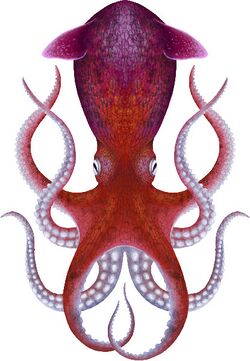Biology:Palaeoctopus
| Palaeoctopus | |
|---|---|

| |
| Holotype of Palaeoctopus newboldi | |
| Scientific classification | |
| Kingdom: | Animalia
|
| Phylum: | |
| Class: | |
| Order: | Octopoda
|
| Suborder: | |
| Family: | |
| Genus: | †Palaeoctopus Woodward, 1896b[1]
|
| Type species | |
| †Palaeoctopus newboldi (Woodward, 1896a)[2]
| |
| Synonyms | |
|
Genus synonymy
Species synonymy
| |
Palaeoctopus is an extinct genus of octopuses that lived during the Late Cretaceous. It contains one valid species, P. newboldi, which has been found in Lebanon.
Taxonomy
Calais newboldi was named by Henry B. Woodward in 1896 for a nearly-complete specimen from the Sahel Alma lagerstätte of Lebanon.[2] However, that genus name was preoccupied by the beetle Calais.[3] Woodward named Palaeoctopus as a replacement later the same year.[1] Embrik Strand proposed the alternate replacement name Calaita in 1928.[4]
Beloteuthis libanotica was named by Adolf Naef in 1922 for a supposed teudopsid gladius from Sahel Alma.[6] It was moved to a new genus, Parateudopsis, by Theo Engeser and Joachim Reitner in 1986.[5] The specimen was eventually reidentified as an isolated gladius vestige of P. newboldi.[7]
A second species, P. pelagicus, was named by Dirk Fuchs and colleagues in 2008 for an alleged gladius vestige from the Vallecillo lagerstätte of Mexico.[8] It was subsequently revealed to be a gular plate from a coelacanth, possibly a juvenile Megalocoelacanthus.[9]
References
- ↑ 1.0 1.1 Woodward, H.B. (1896b). "Calais newboldi". The Geological Magazine. New Series 3 (12): 567. doi:10.1017/S0016756800135022. Bibcode: 1896GeoM....3..567W. https://www.biodiversitylibrary.org/item/96075#page/609/mode/1up.
- ↑ 2.0 2.1 Woodward, H.B. (1896a). "On a fossil octopus (Calais newboldi, J. De C. Sby. MS.) from the Cretaceous of the Lebanon". The Quarterly Journal of the Geological Society of London 52 (206): 229–234. doi:10.1144/GSL.JGS.1896.052.01-04.12. https://zenodo.org/record/2444764/files/article.pdf.
- ↑ 3.0 3.1 Laporte, F.L.N.C. (1838). "Études entomologiques, ou descriptions d'insectes nouveaux et observations sur la synonymie". Revue Entomologique 4: 5–60. https://www.biodiversitylibrary.org/item/82334#page/13/mode/1up.
- ↑ 4.0 4.1 Strand, E. (1928). "Miscellanea nomenclatorica zoologica et palaeontologica. I-II.". Archiv für Naturgeschichte. Abteilung A 92 (8): 30–75. https://mndi.museunacional.ufrj.br/aracnologia/pdfliteratura/Strand%201926%20Miscellanea%20I-II.pdf.
- ↑ 5.0 5.1 Engeser, T.; Reitner, J. (1986). "Coleoid remains from the Late Cretaceous of the Lebanon in the Staatliches Museum für Naturkunde in Stuttgart". Stuttgarter Beiträge zur Naturkunde. Serie B (Geologie und Paläontologie) 124: 1–15. https://www.biodiversitylibrary.org/item/95136#page/521/mode/1up.
- ↑ 6.0 6.1 Naef, A. (1922). Die Fossilen Tintenfische. Jena: Gustav Fischer. doi:10.5962/bhl.title.2082.
- ↑ Fuchs, D. (2010). "A rare and unusual teudopseid coleoid from the Upper Cretaceous of Hâqel (Lebanon)". Ferrantia 59: 61–72. https://ps.mnhn.lu/ferrantia/publications/Ferrantia59.pdf#page=62.
- ↑ Fuchs, D.; Ifrim, C.; Stinnesbeck, W. (2008). "A new Palaeoctopus (Cephalopoda: Coleoidea) from the Late Cretaceous of Vallecillo, north-eastern Mexico, and implications for the evolution of Octopoda". Palaeontology 51 (5): 1129–1139. doi:10.1111/j.1475-4983.2008.00797.x. Bibcode: 2008Palgy..51.1129F.
- ↑ Schultze, H.-P.; Fuchs, D.; Giersch, S.; Ifrim, C.; Stinnesbeck, W. (2010). "Palaeoctopus pelagicus from the Turonian of Mexico reinterpreted as a coelacanth (sarcopterygian) gular plate". Palaeontology 53 (3): 689–694. doi:10.1111/j.1475-4983.2010.00943.x. Bibcode: 2010Palgy..53..689S.
Wikidata ☰ Q3360779 entry
 |


